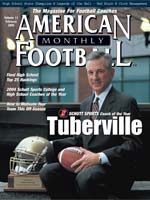Disruptive Behavior
How to maintain a disruptive defense playing a 4-3-2 deep zone concept.
Defensive Coordinator, Pearl River Community College©
More from this issue
The old cliché “The Defense Wins Championships” is definitely true. I can also speak specifically to this after our team, the Pearl River Community College Wildcats, won the 2003 MACJC State Championship and the 2004 National Championship. Not only do I believe this defensive philosophy to be true and to work toward maintaining a defense that will produce champions, but any and all championship contenders must work on developing a defense that will keep the opponent from scoring a great number of points. This was the objective in mind in developing a disruptive defense playing a two-deep zone concept.
In today’s defensive schemes, everyone is trying to create a way to get that extra defender into the offensive box to stop the run. I remember attending a clinic when long time Nebraska secondary coach, George Darlington, lectured on Nebraska’s 11 robber coverage that always allowed them a +1 defensive box number vs. any offensive formation. This placed the defense in a great position to have an unblocked defender vs. most offensive runs (except QB type runs in which box will be even.) However, when you commit that extra box defender to stop the run, it leaves you susceptible to defending the pass with man coverage or voiding zones with a three-deep concept.
We approached spring practice determined to install a two-deep safety coverage concept to help reduce the offense’s opportunities to generate an explosive pass play (+25 or more yards). This type of concern (the play) was addressed by playing hard corners that are alley at flat run defenders and will collision and reroute receivers in the passing game. I was convinced that second deep safety would help “clean up” any mistakes that the front seven might have made in terms of alignment, assignment, or missed tackles.
The next problem that had to be addressed was the defensive concept that could stop the offensive running plays from getting vertical and attacking the second and third levels of the defense. In review, the majority of the explosive runs against our defense got to the second and third levels quickly; therefore, in most cases, the runner did not have to cut back, change directions or hesitate to get to his vertical running seam. Our solution was simple: play a two-deep concept with very little blitzing by the second level (linebackers) while maintaining a disruptive concept by moving the defensive line.
As a defensive staff, we felt that this would cause the offensive line to think about his opponent not being a base-assignment or single technique player and would remove a degree of the aggressiveness from the offensive line when involved in a run blocking scheme. If the offensive lineman stayed extremely aggressive, he would miss a penetrating or looping defensive lineman. In the design and concept of our new defense, we wanted our defensive line to cross-face and penetrate to our set point (one yard past the line of scrimmage, the first defensive lineman to cross the LOS is labeled the penetrator and responsible for recreating the LOS). The DL wants to penetrate at an angle that will allow him to replace the feet, gap assignment, and initial alignment of the Looper. The Looper is the second DL involved in the movement. The Looper also wants to replace the penetrator in terms of feet, gap assignment, and initial alignment; he is usually the back door or cut back defender.
When the movement is executed correctly, it allows the defense to do three very important things to the offense running seams. First, the DL movements cancel a gap through the process crossing and exchanging gap responsibilities. This will allow two defensive linemen to control and regulate three gaps in the running game. Second, it allows the linebackers to play fast and over the top of run plays and play at a depth of six yards so that the second level defenders can react and change direction if a ball carrier cuts the ball back against the grain. Last and most importantly, the movement keeps the ball carrier from attacking the LOS and getting to the second and third level defenders who would not have time to react and recover. We feel that we can funnel and push the football east and west to the sidelines where we have established a hard alley to flat defender in our corners.
In implementing our defensive line movements, we have categorized them into three groups. First are stunts in which 2-4 DL and are executed on ball movements. Second, are reads which involve 1-3 lineman with the direction, penetrator – looper definition. Involvement of the movement is based on the direction, movement and run/pass read that the offensive linemen create. And third are the traditional directional movements that existed for years: slant, angle, pinch; these involve the entire defensive lineman regardless of a 3-man, 4-man, 5-man or 6-man lines.
Attacking the Line of Scrimmage (LOS) In Diagrams 1, 2 and 3 we will exhibit how we run the 1-man reads called “spike, knife and fork.
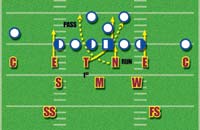
Diagram 1. Spike 3-Tech Penetrator
The tackle takes the A-gap strong and penetrates until he gets to the set point then redirects to ball if a run. If the ball is passed, he still attacks penetrating through the A-gap strong, making a transition to a pass mode, and working to the QB’s left foot which is categorized as one of the four pressure points of the passing pocket. The read aspect is where the nose gets a low hat/run block read from the center/guard; he sits down and plays the A-gap wk vs. run. The key coaching point in the Reads is if the nose gets a high hat/pass set from the center/guard, it triggers him to become the looper and works to the QB’s right foot as the second of the four pressure points of the passing pocket.
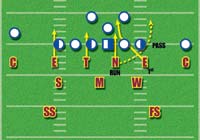
Diagram 2. Knife 5-Tech Wk Pentrator
The weak end takes the B-gap and penetrates to the set point. If the play is a run, the weak end is the wk B-gap defender and the nose is the A-gap weak defender. This causes any weak side run to bounce to the fast flowing linebackers pushing the ball to the sideline and the alley to flat defenders (cornerbacks). If a strong side run progresses, the weak side end will continue to penetrate and stress the LOS compressing the cutback running lane wk. If the bootleg is wk the nose must work back and flat down the LOS to a cutoff position on the QB.
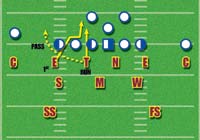
Diagram 3. Fork 9-Tech Stg Penetrator
The strong end takes the C-gap strong and penetrates to the set point. If a run play is executed, the strong end is the strong C-gap defender, and the tackle is the B-gap strong defender. This results in any strong side runs to bounce to the fasts flowing linebackers will push the ball to the sidelines and the alley to flat defenders (cornerbacks). If a weak side run progresses, the strong side end will continue to penetrate and stress the LOS compressing the cutback running lane strong. If bootleg is strong the tackle must work back and flat down the LOS to a cutoff position on the QB.
In diagrams 4, 5 and 6 we will exhibit how we run the two-man Stunts called nat, nose and tex. The stunts are executed on the snap of the ball. The objective of the stunts is to be able to control a three gap responsibility with two defenders. The key coaching point is the two defensive linemen who must execute and finish the stunt regardless of what run/pass action the offensive lineman shows the defense.
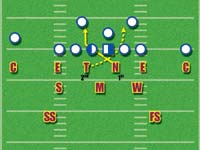
Diagram 4. Nat-Nose-1st/Tacckle-2nd
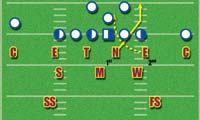
Diagram 5. Nose-1st/End (wk)-2nd
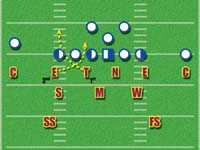
Diagram 6. Tex: tackle-1st/End (stg)-2nd
The nose is the penetrator and takes the A-gap strong on the snap. The key to controlling or “canceling” of the third gap is the nose penetrating through the A-gap strong to the outside hip of the strong offensive guard and working to the B-gap strong set point. The tackle then becomes the looper and “flashes” across the A-gap strong to the outside hip of the offensive center and working to the A-gap wk. In teaching this concept, we feel that if an interior run play is called, we can control the extra gap or in this example A-gap strong by penetrating across it with one defender and then flashing and working across it with the second defender. In our game and practice experiences, when a ball carrier uses his eyes (vision) and sees a penetrator, flasher or looper, it causes him to hesitate, cutback, or bounce the wall which allows the first level (DL) and the second level (LB) defenders to react to the play. The disruption caused by a penetration scheme forces the offensive line and running backs to adjust to the defense’s movement and aggression.
The nose is the penetrator and takes the B-gap wk on the snap and works to the C-gap wk set point. As the nose penetrates the B-gap wk, his aiming point is the outside hip of the offensive tackle which should put him about one yard deep to the C-gap wk set point. The wk end then becomes the looper and “flashes” across the B-gap wk to the inside hip of the offensive center and working to the A-gap wk. When this stunt is executed correctly, the defense feels that the gaps A-wk and C-gap wk have been controlled with defenders and regulate the B-gap wk through movement. Theoretically, we have been able to cancel a gap responsibility allowing our defense to play with one less player in the box. This defensive concept has allowed us to control the offensive running game without sinking a safety into the box for run support, permitting the maintenance of a two-deep safety type coverage.
(See Diagram 6.)
The tackle is the penetrator taking the C-gap strong on the snap working to the D-gap strong set point. As the tackle penetrates the C-gap strong, his aiming point is the outside hip of the tight end which should put him approximately one yard deep to the D-gap strong set point. The strong end then becomes the looper and “flashes” across the C-gap strong to the outside hip of the strong offensive guard and while working to the B-gap strong. The defense has controlled the D-gap strong and B-gap strong with defenders and regulated the C-gap strong through movement.
Diagrams 7 and 8 are examples of the double one-man read called choice. This read is executed out of our even front where we play two two-tech tackles. The choice read is excellent versus any type of zone running schemes and most man or zone type pass protection. The read aspect takes place off of the direction and initial movement of the center. The objective of this read is to have a penetrator and a looper who develops into a cutback player versus zone running schemes. The key to the execution of this read is the penetrator’s ability to jump the A-gap while moving his feet until arriving at the set point or outside hip of the opposite site guard. The looper then replaces the penetrator as he folds back around and develops into the cutback defender.
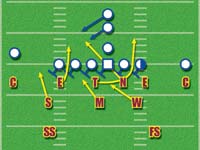
Diagram 7. Even-choice; center-direction stg
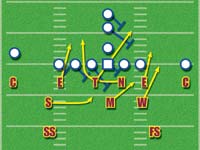
Diagram 8. Even-choice; Center-direction wk
Base Responsibilities vs. Strong side run flow with Even-Choice
D-gap strong = Sam LB
C-gap strong = Strong DE
B-gap strong = Mike LB
A-gap strong = Nose (penetrator)
A-gap wk = Will LB
B-gap wk = Tackle (looper)
C-gap wk = Wk DE
A key coaching point in the execution of even-choice occurs as the run play develops, the nose continues flat down the LOS (about one yard in depth) to the B-gap strong. This penetration should cause the runner to push the ball to the C-gap, alley, and eventually the sideline. The Mike LB, because of his depth alignment of six yards, can redirect from his B-gap strong responsibility and now can be a spill player who develops into a D-gap strong to sideline defender.
D-gap wk = Will LB
C-gap wk = Wk DE
B-gap wk = Mike LB
A-gap wk = Tackle (penetrator)
A-gap strong = Sam LB
B-gap strong = Nose (looper)
C-gap strong = Strong DE
In Diagrams 7 and 8 the even-choice is executed as a wk-side run develops. The tackle becomes the penetrator and will go flat off the centers butt to the A-gap wk and working to the B-gap wk to the alley on a natural progression down the LOS. The nose folds away from the center and becomes the looper and cutback defender in the B-gap strong. The Mike LB is the B-gap wk defender and will mirror the RB with flow to the sideline. From game and practice film, it is apparent the RB’s vision will cause his track to change as he sees the tackle penetrating down the LOS and the Mike LB pressing the B-gap wk.
A good RB instinctively will do two things: first, he will bounce the ball until it is not “cloudy” and develops into a clear running seam or, second, plant with his outside foot and cutback across the grain to get a quick vertical running seam. If the RB bounces the ball, the penetrating tackle should help to push the ball to the Mike LB, Weak DE, Will LB, and finally to the CB on the perimeter. If the RB cuts back, the nose will be folding back over the top of the center expecting the cutback runner in the strong A-gap/B-gap territory. The nose will develop into the unblocked defender if he uses his eyes to find the ball as he loops over the top of the center. In most situations, the ball carrier is looking for the Mike LB and the backside OLB for his cutback read. The runner never expects the Nose to appear as the strong A-B gap defender.
Diagrams 9 and 10 exhibit how two-man reads, called thunder & lightning, are run.
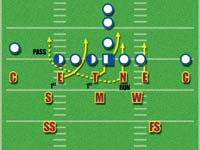
Diagram 9. Thunder stg End/Tackle Penetrators
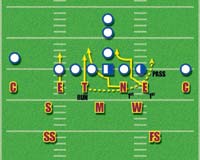
Diagram 10. Lightning wk end Nose/penetrator
In Thunder, the tackle penetrates through the A-gap strong until he gets to his set point. The strong end penetrates through the C-gap strong until he gets to his set point. If the offense calls a wk-side run, the strong side end and tackle penetrate, discouraging the cutback run strong and causing the ball carrier to be pushed with leverage to the wk B -gap to sideline progression. If the offense calls a strong side run, the strong end becomes the strong C-gap defender and progresses to the strong B-gap. The tackle becomes the A-gap strong defender working to the center’s outside hip. This penetration discourages the cutback wk and will cause the ball to be pushed to the D-gap strong to the sideline.
A key coaching point to this read is that when the strong end goes underneath the TE, and the TE washes him down, the Sam LB attacks the D-gap with eyes inside ready to spill everything to the alley and sideline. If he cannot make the tackle himself, the Mike LB transitions to an angle runner and pushes the ball carrier to the cornerback. The read aspect is when the nose gets a low hat and pad level run read from the center/guard. At this point, he sits down and plays the A-gap wk run responsibility. However, if the Nose gets a high hat/pass set key from the center/guard it triggers him to become looper and replace the strong DE as the outside contain rusher on the strong side. The tackle works to an inside pressure point on the QB’s left foot, and the strong end works to the second inside pressure point on the QB’s right foot. This provides a solid push in the QB’s face with the goals of disrupting his down field vision, changing his natural escape routes for the QB, and distorting the throwing lanes to the WR’s. If the defense can execute this two-man read it is an excellent disruption call versus the run and can give the framework to have a quality pass rush emphasizing the four pressure points of the QB.
In Lightning, the Nose crosses the face of the center and penetrates through the A-gap strong until he gets to his set point. The wk end penetrates through the B-gap wk until he gets to his set point. If the offense calls a strong side run, the wk side end and nose penetrate discouraging the cutback run which causes the ball carrier to be pushed with leverage to the C-gap strong to sideline progression. If the offense calls a wk side run, the wk end becomes the B-gap wk defender and progresses to the A-gap wk. The Nose becomes the A-gap strong defender and works to the outside hip of the guard. This penetration discourages the cutback strong and will cause the ball to be pushed to the C-gap wk to the sideline.
A key coaching point to this read occurs when the wk end goes underneath the OT and the OT washes him down. This will cause the LB to attack the C-gap wk with eyes inside ready to spill everything to the alley and sideline. The Mike LB then transitions to an angle runner and pushes the ball carrier to the cornerback if he cannot make the tackle himself. The read aspect transpires when the tackle gets a low hat and pad level run read from the center/guard. The tackle sits down and plays the B-gap strong run responsibility. However, if the tackle gets a high hat/pass set key from the guard, it triggers him to become the looper and replaces the weak DE as the outside contain rusher on the wk side. The nose works to an inside pressure point on the QB’s right foot, and the wk end works to the second inside pressure point on the QB’s left foot giving us a solid push in the QB’s face. If the defense can execute this two-man read, it is an excellent disruption call against the run and can provide the framework to have a quality pass rush emphasizing the four pressure points of the QB.
In conclusion, the theory of having a disruptive defense while maintaining a very sound and safe framework against explosive plays by the offense was an attainable goal through research and trial/error in practice. Through our overall record and defensive statistics, the PRCC Defense feels we have found a philosophy to hang our hat on and give us a chance to “stop ‘em” and win every week. Related Videos
American Football Monthly now offers a full line of coaching videos. So, if you enjoyed this clinic article, here are a few videos that you may find interesting:
FV 01773 Cover 8 Defense: Basic Coverage for Your Secondary (Parker)
FV 01294A 8 in the Box: Designing the System (Skladany)
FV00048E Defensive Middle Guard (McBride)
To find these videos and many others, view our online catalog at
www.AFMVideos.com.
About the author
William Jones
William Jones just completed his fourth season as Defensive Coordinator at Pearl River Community College. This fall the Wildcats completed an undefeated season and defeated Butler County Community College in the Dalton Defenders Bowl, 35-14. Jones also serves as Academic Coordinator, Recruiting Coordinator and a Health and Physical Education Instructor at PRCC. You can reach him at wjones@prcc.edu.
